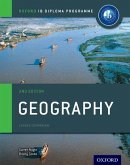- Broschiertes Buch
- Merkliste
- Auf die Merkliste
- Bewerten Bewerten
- Teilen
- Produkt teilen
- Produkterinnerung
- Produkterinnerung
Prepare learners for IB assessment. Fully updated to cover the revised syllabus for first examination 2019, this comprehensive Study Guide reinforces the essential understanding learners need for IB exams. With an accessible format that clarifies and explains all the essential principles, this book supports maximum achievement in assessment.
Andere Kunden interessierten sich auch für
![Business Management Study Guide: Oxford IB Diploma Programme Business Management Study Guide: Oxford IB Diploma Programme]() Lloyd GutteridgeBusiness Management Study Guide: Oxford IB Diploma Programme49,99 €
Lloyd GutteridgeBusiness Management Study Guide: Oxford IB Diploma Programme49,99 €![Biology Study Guide 2014 edition: Oxford IB Diploma Programme Biology Study Guide 2014 edition: Oxford IB Diploma Programme]() Andrew AllottBiology Study Guide 2014 edition: Oxford IB Diploma Programme32,99 €
Andrew AllottBiology Study Guide 2014 edition: Oxford IB Diploma Programme32,99 €![The Cold War - Superpower Tensions and Rivalries: IB History Course Book: Oxford IB Diploma Programme The Cold War - Superpower Tensions and Rivalries: IB History Course Book: Oxford IB Diploma Programme]() Alexis MamauxThe Cold War - Superpower Tensions and Rivalries: IB History Course Book: Oxford IB Diploma Programme39,99 €
Alexis MamauxThe Cold War - Superpower Tensions and Rivalries: IB History Course Book: Oxford IB Diploma Programme39,99 €![Authoritarian States: IB History Course Book: Oxford IB Diploma Programme Authoritarian States: IB History Course Book: Oxford IB Diploma Programme]() Brian GrayAuthoritarian States: IB History Course Book: Oxford IB Diploma Programme41,99 €
Brian GrayAuthoritarian States: IB History Course Book: Oxford IB Diploma Programme41,99 €![Authoritarian States: IB History Print and Online Pack: Oxford IB Diploma Programme Authoritarian States: IB History Print and Online Pack: Oxford IB Diploma Programme]() Brian GrayAuthoritarian States: IB History Print and Online Pack: Oxford IB Diploma Programme84,99 €
Brian GrayAuthoritarian States: IB History Print and Online Pack: Oxford IB Diploma Programme84,99 €![Oxford IB Diploma Programme: Geography Course Companion Oxford IB Diploma Programme: Geography Course Companion]() Garrett NagleOxford IB Diploma Programme: Geography Course Companion58,99 €
Garrett NagleOxford IB Diploma Programme: Geography Course Companion58,99 €![Oxford IB Study Guides: Economics for the IB Diploma Oxford IB Study Guides: Economics for the IB Diploma]() Constantine ZiogasOxford IB Study Guides: Economics for the IB Diploma34,99 €
Constantine ZiogasOxford IB Study Guides: Economics for the IB Diploma34,99 €-
-
-
Prepare learners for IB assessment. Fully updated to cover the revised syllabus for first examination 2019, this comprehensive Study Guide reinforces the essential understanding learners need for IB exams. With an accessible format that clarifies and explains all the essential principles, this book supports maximum achievement in assessment.
Hinweis: Dieser Artikel kann nur an eine deutsche Lieferadresse ausgeliefert werden.
Hinweis: Dieser Artikel kann nur an eine deutsche Lieferadresse ausgeliefert werden.
Produktdetails
- Produktdetails
- Verlag: Oxford University Press
- 2 Revised edition
- Seitenzahl: 224
- Erscheinungstermin: 7. September 2017
- Englisch
- Abmessung: 297mm x 215mm x 17mm
- Gewicht: 616g
- ISBN-13: 9780198396079
- ISBN-10: 0198396074
- Artikelnr.: 49152381
- Herstellerkennzeichnung
- Libri GmbH
- Europaallee 1
- 36244 Bad Hersfeld
- gpsr@libri.de
- Verlag: Oxford University Press
- 2 Revised edition
- Seitenzahl: 224
- Erscheinungstermin: 7. September 2017
- Englisch
- Abmessung: 297mm x 215mm x 17mm
- Gewicht: 616g
- ISBN-13: 9780198396079
- ISBN-10: 0198396074
- Artikelnr.: 49152381
- Herstellerkennzeichnung
- Libri GmbH
- Europaallee 1
- 36244 Bad Hersfeld
- gpsr@libri.de
Option A
1: Drainage basin hydrology and geomorphology
2: Flooding and flood mitigation
3: Water scarcity and water quality
4: Water management futures
Option B
1: Ocean-atmosphere interactions
2: Interactions between oceans and the coastal places
3: Managing coastal margins
4: Ocean management futures
Option C
1: The characteristics of extreme environments
2: Physical processes and landscapes
3: Managing extreme environments
4: Extreme environments' futures
Option D
1: Geophysical systems
2: Geophysical hazard risks
3: Hazard risk and vulnerability
4: Future resilience and adaptation
Option E
1: Changing leisure patterns
2: Tourism and sport at the local and national scale
3: Tourism and sport at the international scale
4: Managing tourism and sport for the future
Option F
1: Measuring food and health
2: Food systems and the spread of disease
3: Stakeholders in food and health
4: Future health and food security sustainability
Option G
1: The variety of urban environments
2: Changing urban systems
3: Urban environmental and social stresses
4: Building sustainable urban systems for the future
Unit 1
1: Population and economic development patterns
2: Changing populations and places
3: Challenges and opportunities
Unit 2
1: The causes of global climate change
2: The consequences of global climate change
3: Responding to climate change
Unit 3
1: Global trends in consumption
2: Impacts of changing trends in resource consumption
3: Resource stewardship
Unit 4
1: Global interactions and global power
2: Global networks and flows
3: Human and physical influences on global interactions
Unit 5
1: Development opportunities
2: Changing identities and cultures
3: Local responses to global interactions
Unit 6
1: Geopolitical and economic risks
2: Environmental risks
3: Local and global resilience
1: Drainage basin hydrology and geomorphology
2: Flooding and flood mitigation
3: Water scarcity and water quality
4: Water management futures
Option B
1: Ocean-atmosphere interactions
2: Interactions between oceans and the coastal places
3: Managing coastal margins
4: Ocean management futures
Option C
1: The characteristics of extreme environments
2: Physical processes and landscapes
3: Managing extreme environments
4: Extreme environments' futures
Option D
1: Geophysical systems
2: Geophysical hazard risks
3: Hazard risk and vulnerability
4: Future resilience and adaptation
Option E
1: Changing leisure patterns
2: Tourism and sport at the local and national scale
3: Tourism and sport at the international scale
4: Managing tourism and sport for the future
Option F
1: Measuring food and health
2: Food systems and the spread of disease
3: Stakeholders in food and health
4: Future health and food security sustainability
Option G
1: The variety of urban environments
2: Changing urban systems
3: Urban environmental and social stresses
4: Building sustainable urban systems for the future
Unit 1
1: Population and economic development patterns
2: Changing populations and places
3: Challenges and opportunities
Unit 2
1: The causes of global climate change
2: The consequences of global climate change
3: Responding to climate change
Unit 3
1: Global trends in consumption
2: Impacts of changing trends in resource consumption
3: Resource stewardship
Unit 4
1: Global interactions and global power
2: Global networks and flows
3: Human and physical influences on global interactions
Unit 5
1: Development opportunities
2: Changing identities and cultures
3: Local responses to global interactions
Unit 6
1: Geopolitical and economic risks
2: Environmental risks
3: Local and global resilience
Option A
1: Drainage basin hydrology and geomorphology
2: Flooding and flood mitigation
3: Water scarcity and water quality
4: Water management futures
Option B
1: Ocean-atmosphere interactions
2: Interactions between oceans and the coastal places
3: Managing coastal margins
4: Ocean management futures
Option C
1: The characteristics of extreme environments
2: Physical processes and landscapes
3: Managing extreme environments
4: Extreme environments' futures
Option D
1: Geophysical systems
2: Geophysical hazard risks
3: Hazard risk and vulnerability
4: Future resilience and adaptation
Option E
1: Changing leisure patterns
2: Tourism and sport at the local and national scale
3: Tourism and sport at the international scale
4: Managing tourism and sport for the future
Option F
1: Measuring food and health
2: Food systems and the spread of disease
3: Stakeholders in food and health
4: Future health and food security sustainability
Option G
1: The variety of urban environments
2: Changing urban systems
3: Urban environmental and social stresses
4: Building sustainable urban systems for the future
Unit 1
1: Population and economic development patterns
2: Changing populations and places
3: Challenges and opportunities
Unit 2
1: The causes of global climate change
2: The consequences of global climate change
3: Responding to climate change
Unit 3
1: Global trends in consumption
2: Impacts of changing trends in resource consumption
3: Resource stewardship
Unit 4
1: Global interactions and global power
2: Global networks and flows
3: Human and physical influences on global interactions
Unit 5
1: Development opportunities
2: Changing identities and cultures
3: Local responses to global interactions
Unit 6
1: Geopolitical and economic risks
2: Environmental risks
3: Local and global resilience
1: Drainage basin hydrology and geomorphology
2: Flooding and flood mitigation
3: Water scarcity and water quality
4: Water management futures
Option B
1: Ocean-atmosphere interactions
2: Interactions between oceans and the coastal places
3: Managing coastal margins
4: Ocean management futures
Option C
1: The characteristics of extreme environments
2: Physical processes and landscapes
3: Managing extreme environments
4: Extreme environments' futures
Option D
1: Geophysical systems
2: Geophysical hazard risks
3: Hazard risk and vulnerability
4: Future resilience and adaptation
Option E
1: Changing leisure patterns
2: Tourism and sport at the local and national scale
3: Tourism and sport at the international scale
4: Managing tourism and sport for the future
Option F
1: Measuring food and health
2: Food systems and the spread of disease
3: Stakeholders in food and health
4: Future health and food security sustainability
Option G
1: The variety of urban environments
2: Changing urban systems
3: Urban environmental and social stresses
4: Building sustainable urban systems for the future
Unit 1
1: Population and economic development patterns
2: Changing populations and places
3: Challenges and opportunities
Unit 2
1: The causes of global climate change
2: The consequences of global climate change
3: Responding to climate change
Unit 3
1: Global trends in consumption
2: Impacts of changing trends in resource consumption
3: Resource stewardship
Unit 4
1: Global interactions and global power
2: Global networks and flows
3: Human and physical influences on global interactions
Unit 5
1: Development opportunities
2: Changing identities and cultures
3: Local responses to global interactions
Unit 6
1: Geopolitical and economic risks
2: Environmental risks
3: Local and global resilience








